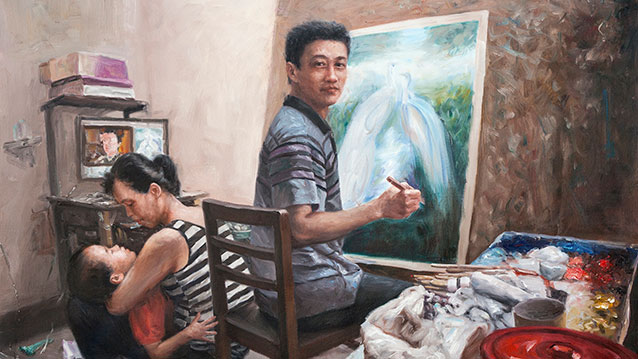EVANSTON, Ill. --- Lens-based artist Priscilla Briggs uses her camera to examine the shifts in identity and values in the global market system. Her solo exhibition focuses on the Wushipu and Haicang oil-painting communities of Xiamen, China -- a billion-dollar industry -- and how mass production has changed the understanding of authorship, authenticity, labor and the artist.
“Making Mona Lisa” opens at Northwestern University’s Dittmar Memorial Gallery on Thursday, Sept. 18 with a reception from 6 to 8 p.m. and runs through Oct. 24. The gallery is located on the first floor of Norris University Center, 1999 Campus Drive. The exhibit and the opening reception are free and open to the public.
Briggs’ work contemplates mass production’s influence on labor practices as they relate to art and craft. Her Dittmar show includes still-life photographs of the Chinese artists’ studios where they live and work as well as oil paintings by various artists of Briggs’ photographic portraits of the workers. It is a combination that brings attention to the ways in which the replica painting is created and to art as laborious work done in studios often shared with other commercial painters.
Briggs spent a total of two months in the coastal city of Xiamen during two separate one-month artist residencies at the Chinese European Art Center, which she chose because of its booming oil painting industry. Located at the southeast corner of China, Xiamen’s scenic seascape is popular with tourists who buy reproductions of the great European masters to hang in their homes or offices. Other art replicas are exported to foreign countries where they end up in tourist galleries, hotels and furniture stores.
“Most of the artists in these communities don’t think much about authorship and authenticity in regard to the (art) industry,” Briggs said. “They think in terms of whether something is commercial (a copy of a reproduction or style) or their own original creation.”
Briggs said they see the commercial work they do as a job rather than an artistic practice. They do not sign their names to the works. However, if works are being sold in a foreign tourist market they tend to be signed with a foreign name. Xiamen’s painters take great pride in a copy that looks exactly like the original.
One of the highlights of the exhibition is an oil painting over inkjet print on canvas titled “Mr. Lin.” It depicts a sepia-toned commercial artist seated on a stool in front of his large sketch of da Vinci’s famous half-length portrait of “Mona Lisa.” Briggs commissioned Lin to paint a “Mona Lisa” for her in its original smaller size and videotaped him making the painting, which took two days.
“He asked $75 for the painting, a fee that is probably higher than he normally makes,” Briggs said. “Since most of the painters do not speak English, they rely on the dealers to sell their work. However, the Internet is changing this to a certain extent.”
Briggs lives in Minneapolis and is an associate professor in art and art history at Gustavus Adolphus College in St. Peter, Minn., where she teaches darkroom and digital photography as well as video art. For more information on Briggs, visit http://priscillabriggs.com/home.html.


